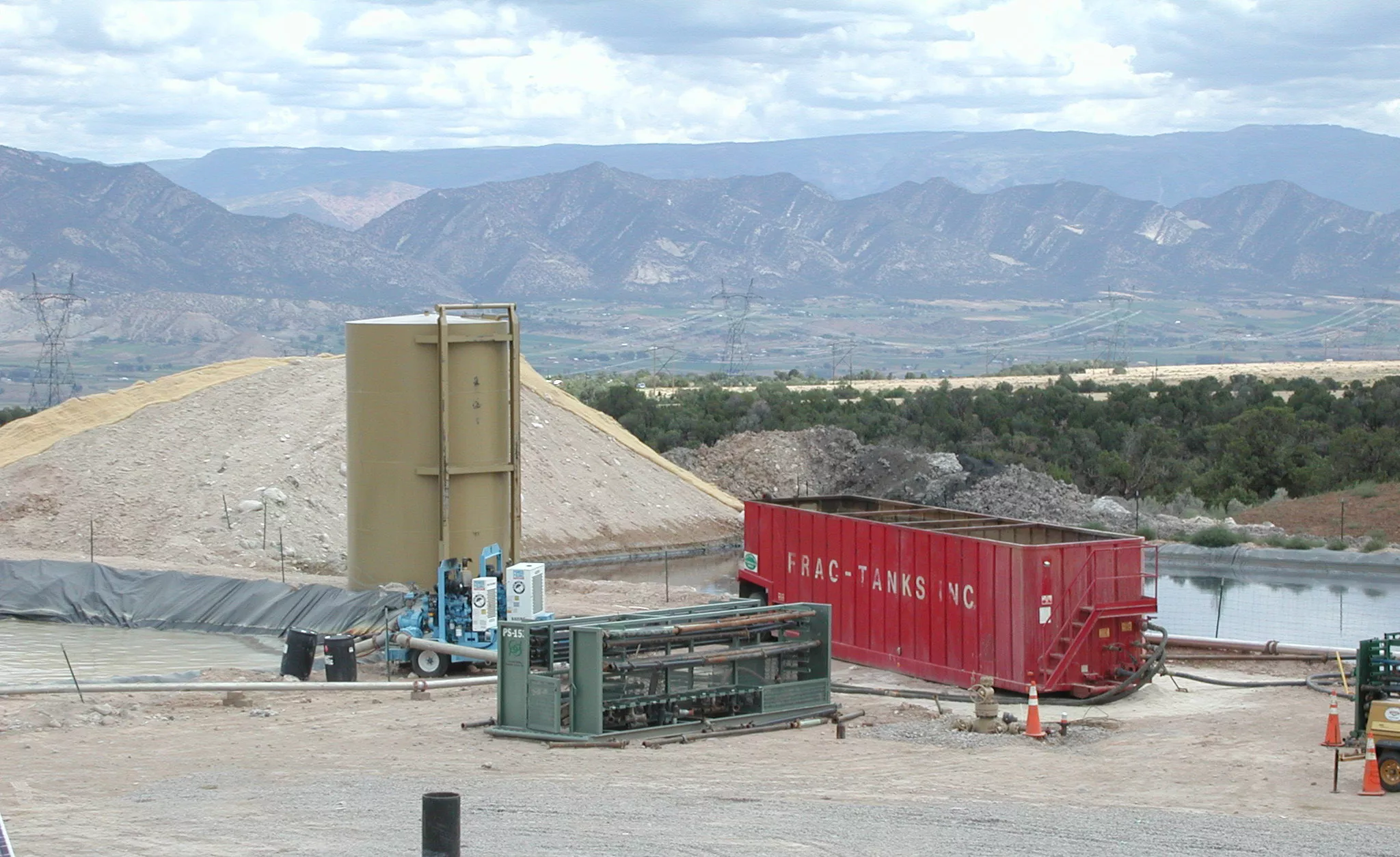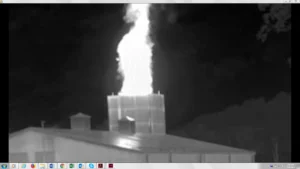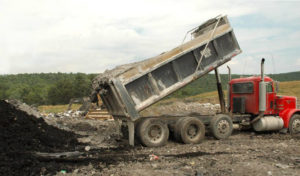Hydraulic Fracturing – What is Fracking?
Geologic formations may contain large quantities of oil or gas, but have a poor flow rate due to low permeability, or from damage or clogging of the formation during drilling. This is particularly true for tight sands, shales and coalbed methane formations.
Hydraulic fracturing (aka fracking, which rhymes with cracking) stimulates wells drilled into these formations, making profitable otherwise prohibitively expensive extraction. Within the past decade, the combination of hydraulic fracturing with horizontal drilling has opened up shale deposits across the country and brought large-scale natural gas drilling to new regions.
The fracking process occurs after a well has been drilled and steel pipe (casing) has been inserted in the well bore. The casing is perforated within the target zones that contain oil or gas, so that when the fracturing fluid is injected into the well it flows through the perforations into the target zones.
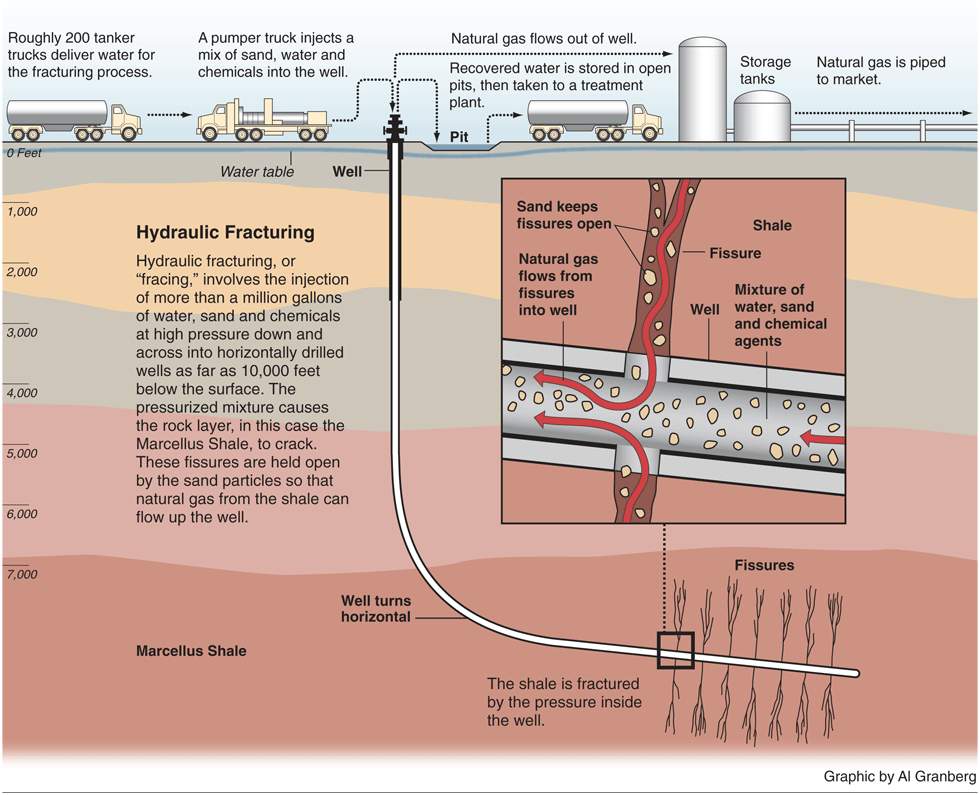
Eventually, the target formation will not be able to absorb the fluid as quickly as it is being injected. At this point, the pressure created causes the formation to crack or fracture. Once the fractures have been created, injection ceases and the fracturing fluids begin to flow back to the surface.
Materials called proppants (e.g., usually sand or ceramic beads), which were injected as part of the frac fluid mixture, remain in the target formation to hold open the fractures.
Typically, a mixture of water, proppants and chemicals is pumped into the rock or coal formation. There are, however, other ways to fracture wells. Sometimes fractures are created by injecting gases such as propane or nitrogen, and sometimes acidizing occurs simultaneously with fracturing. Acidizing involves pumping acid (usually hydrochloric acid), into the formation to dissolve some of the rock material to clean out pores and enable gas and fluid to flows more readily into the well.
Some studies have shown that more than 90% of fracking fluids may remain underground. Used fracturing fluids that return to the surface are often referred to as flowback, and these wastes are typically stored in open pits or tanks at the well site prior to disposal.
Hydraulic Fracturing – Issues and Impacts
The process of fracturing a well is far from benign. The following sections provide an overview of some of the issues and impacts related to this well stimulation technique.
- Water use
- Sand and proppants
- Toxic chemicals
- Health concerns
- Surface water and soil contamination
- Groundwater contamination
- Air quality
- Waste disposal
- Chemical disclosure
Water Use
In 2010, the U.S. Environmental Protection Agency estimated that 70 to 140 billion gallons of water are used to fracture 35,000 wells in the United States each year. This is approximately the annual water consumption of 40 to 80 cities each with a population of 50,000. Fracture treatments in coalbed methane wells use from 50,000 to 350,000 gallons of water per well, while deeper horizontal shale wells can use anywhere from 2 to 10 million gallons of water to fracture a single well. The extraction of so much water for fracking has raised concerns about the ecological impacts to aquatic resources, as well as dewatering of drinking water aquifers.
It has been estimated that the transportation of two to five million gallons of water (fresh or waste water) requires 1,400 truck trips. Thus, not only does water used for hydraulic fracturing deplete fresh water supplies and impact aquatic habitat, the transportation of so much water also creates localized air quality, safety and road repair issues.
Sand and Proppants
Conventional oil and gas wells use, on average, 300,000 pounds of proppant, coalbed fracture treatments use anywhere from 75,000 to 320,000 pounds of proppant and shale gas wells can use more than 4 million pounds of proppant per well.
Frac sand mines are springing up across the country, from Wisconsin to Texas, bringing with them their own set of impacts. Mining sand for proppant use generates its own range of impacts, including water consumption and air emissions, as well as potential health problems related to crystalline silica.
Toxic Chemicals
In addition to large volumes of water, a variety of chemicals are used in hydraulic fracturing fluids. The oil and gas industry and trade groups are quick to point out that chemicals typically make up just 0.5 and 2.0% of the total volume of the fracturing fluid. When millions of gallons of water are being used, however, the amount of chemicals per fracking operation is very large. For example, a four million gallon fracturing operation would use from 80 to 330 tons of chemicals.[1]
As part of New York State’s Draft Supplemental Generic Environmental Impact Statement (SGEIS) related to Horizontal Drilling and High-Volume Hydraulic Fracturing in the Marcellus Shale, the Department of Environmental Conservation complied a list of chemicals and additives used during hydraulic fracturing. The table below provides examples of various types of hydraulic fracturing additives proposed for use in New York. Chemicals in brackets [ ] have not been proposed for use in the state, but are known to be used in other states or shale formations.
Examples of Chemicals and Additives Used During Hydraulic Fracturing
- Proppant – “Props” open fractures and allows gas / fluids to flow more freely to the well bore. Examples: Sand [Sintered bauxite; zirconium oxide; ceramic beads]
- Acid – Cleans up perforation intervals of cement and drilling mud prior to fracturing fluid injection, and provides accessible path to formation. Examples: Hydrochloric acid (HCl, 3% to 28%) or muriatic acid
- Breaker – Reduces the viscosity of the fluid in order to release proppant into fractures and enhance the recovery of the fracturing fluid. Examples: Peroxydisulfates
- Bactericide / Biocide – Inhibits growth of organisms that could produce gases (particularly hydrogen sulfide) that could contaminate methane gas. Also prevents the growth of bacteria which can reduce the ability of the fluid to carry proppant into the fractures. Examples: Gluteraldehyde; 2-Bromo-2-nitro-1,2-propanediol
- Buffer / pH Adjusting Agent – Adjusts and controls the pH of the fluid in order to maximize the effectiveness of other additives such as crosslinkers. Examples: Sodium or potassium carbonate; acetic acid
- Clay Stabilizer / Control – Prevents swelling and migration of formation clays which could block pore spaces thereby reducing permeability. Examples: Salts (e.g., tetramethyl ammonium chloride) [Potassium chloride]
- Corrosion Inhibitor – Reduces rust formation on steel tubing, well casings, tools, and tanks (used only in fracturing fluids that contain acid). Examples: Methanol; ammonium bisulfate for Oxygen Scavengers
- Crosslinker – The fluid viscosity is increased using phosphate esters combined with metals. The metals are referred to as crosslinking agents. The increased fracturing fluid viscosity allows the fluid to carry more proppant into the fractures. Examples: Potassium hydroxide; borate salts
- Friction Reducer – Allows fracture fluids to be injected at optimum rates and pressures by minimizing friction. Examples: Sodium acrylate-acrylamide copolymer; polyacrylamide (PAM); petroleum distillates
- Gelling Agent – Increases fracturing fluid viscosity, allowing the fluid to carry more proppant into the fractures. Examples: Guar gum; petroleum distillate
- Iron Control – Prevents the precipitation of carbonates and sulfates (calcium carbonate, calcium sulfate, barium sulfate) which could plug off the formation. Examples: Ammonium chloride; ethylene glycol; polyacrylate
- Solvent – Additive which is soluble in oil, water & acid-based treatment fluids which is used to control the wettability of contact surfaces or to prevent or break emulsions. Examples: Various aromatic hydrocarbons
- Surfactant – Reduces fracturing fluid surface tension thereby aiding fluid recovery. Examples: Methanol; isopropanol; ethoxylated alcohol
Many fracturing fluid chemicals are known to be toxic to humans and wildlife, and several are known to cause cancer. Potentially toxic substances include petroleum distillates such as kerosene and diesel fuel (which contain benzene, ethylbenzene, toluene, xylene, naphthalene and other chemicals); polycyclic aromatic hydrocarbons; methanol; formaldehyde; ethylene glycol; glycol ethers; hydrochloric acid; and sodium hydroxide.
Very small quantities of some fracking chemicals are capable of contaminating millions of gallons of water. According to the Environmental Working Group, petroleum-based products known as petroleum distillates such as kerosene (also known as hydrotreated light distillates, mineral spirits, and a petroleum distillate blends) are likely to contain benzene, a known human carcinogen that is toxic in water at levels greater than five parts per billion (or 0.005 parts per million).
Other chemicals, such as 1,2-Dichloroethane are volatile organic compounds (VOCs). Volatile organic constituents have been shown to be present in fracturing fluid flowback wastes at levels that exceed drinking water standards. For example, testing of flowback samples from Texas have revealed concentrations of 1,2-Dichloroethane at 1,580 ppb, which is more than 316 times EPA’s Maximum Contaminant Level for 1,2-Dichloroethane in drinking water.
VOCs not only pose a health concern while in the water, the volatile nature of the constituents means that they can also easily enter the air. According to researchers at the University of Pittsburgh’s Center for Healthy Environments and Communities, organic compounds brought to the surface in the fracturing flowback or produced water often go into open impoundments (frac ponds), where the volatile organic chemicals can offgas into the air.
When companies have an excess of unused hydraulic fracturing fluids, they either use them at another job or dispose of them. Some Material Safety Data Sheets (MSDSs) include information on disposal options for fracturing fluids and additives. The table below summarizes the disposal considerations that the company Schlumberger Technology Corp. (“Schlumberger”) includes in its MSDSs.[2]
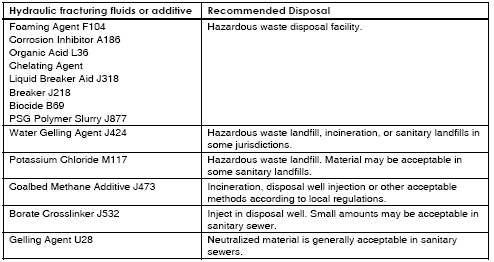
As seen in the table, Schlumberger recommends that many fracturing fluid chemicals be disposed of at hazardous waste facilities. Yet these same fluids (in diluted form) are allowed to be injected directly into or adjacent to USDWs. Under the Safe Drinking Water Act, hazardous wastes may not be injected into USDWs. Moreover, even if hazardous wastes are decharacterized (for example, diluted with water so that they are rendered non-hazardous), wastes must still be injected into a formation that is below the USDW.
Clearly, some hydraulic fracturing fluids contain chemicals deemed to be “hazardous wastes.” Even if these chemicals are diluted it is unconscionable that EPA is allowing these substances to be injected directly into underground sources of drinking water.
Health Concerns
Human exposure to fracking chemicals can occur by ingesting chemicals that have spilled and entered drinking water sources, through direct skin contact with the chemicals or wastes (e.g., by workers, spill responders or health care professionals), or by breathing in vapors from flowback wastes stored in pits or tanks.
In 2010, Theo Colborn and three co-authors published a paper entitled Natural Gas Operations from a Public Health Perspective. Colborn and her co-authors summarized health effect information for 353 chemicals used to drill and fracture natural gas wells in the United States. Health effects were broken into 12 categories: skin, eye and sensory organ, respiratory, gastrointestinal and liver, brain and nervous system, immune, kidney, cardiovascular and blood, cancer, mutagenic, endocrine disruption, other, and ecological effects. The chart below illustrates the possible health effects associated with the 353 natural gas-related chemicals for which Colborn and her co-authors were able to gather health-effects data.
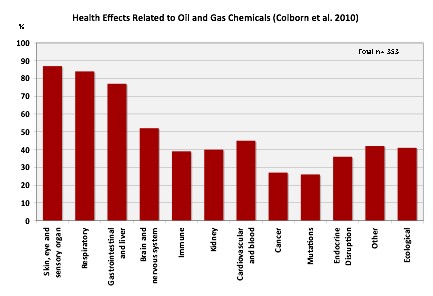
Colborn’s paper provides a list of 71 particularly nasty drilling and fracturing chemicals, i.e., those that are associated with 10 or more health effects.
Natural gas drilling and hydraulic fracturing chemicals with 10 or more health effects
- 2,2′,2″-Nitrilotriethanol
- 2-Ethylhexanol
- 5-Chloro-2-methyl-4-isothiazolin-3-one
- Acetic acid
- Acrolein
- Acrylamide (2-propenamide)
- Acrylic acid
- Ammonia
- Ammonium chloride
- Ammonium nitrate
- Aniline
- Benzyl chloride
- Boric acid
- Cadmium
- Calcium hypochlorite
- Chlorine
- Chlorine dioxide
- Dibromoacetonitrile 1
- Diesel 2
- Diethanolamine
- Diethylenetriamine
- Dimethyl formamide
- Epidian
- Ethanol (acetylenic alcohol)
- Ethyl mercaptan
- Ethylbenzene
- Ethylene glycol
- Ethylene glycol monobutyl ether (2-BE)
- Ethylene oxide
- Ferrous sulfate
- Formaldehyde
- Formic acid
- Fuel oil #2
- Glutaraldehyde
- Glyoxal
- Hydrodesulfurized kerosene
- Hydrogen sulfide
- Iron
- Isobutyl alcohol (2-methyl-1-propanol)
- Isopropanol (propan-2-ol)
- Kerosene
- Light naphthenic distillates, hydrotreated
- Mercaptoacidic acid
- Methanol
- Methylene bis(thiocyanate)
- Monoethanolamine
- NaHCO3
- Naphtha, petroleum medium aliphatic
- Naphthalene
- Natural gas condensates
- Nickel sulfate
- Paraformaldehyde
- Petroleum distillate naptha
- Petroleum distillate/ naphtha
- Phosphonium, tetrakis(hydroxymethyl)-sulfate
- Propane-1,2-diol
- Sodium bromate
- Sodium chlorite (chlorous acid, sodium salt)
- Sodium hypochlorite
- Sodium nitrate
- Sodium nitrite
- Sodium sulfite
- Styrene
- Sulfur dioxide
- Sulfuric acid
- Tetrahydro-3,5-dimethyl-2H-1,3,5-thiadiazine-2-thione (Dazomet)
- Titanium dioxide
- Tributyl phosphate
- Triethylene glycol
- Urea
- Xylene
While Colborn and her co-workers focused on chemicals used in natural gas development, the chemicals used to fracture oil wells are very similar or the same. Looking at some of the oil wells that have been developed in the Bakken Shale in North Dakota, the fracturing fluid mixtures include some of the chemicals shown by Colborn to have the potential to cause 10 or more adverse health effects. Information posted hydraulic fracturing fluid chemicals on the FracFocus web site indicates that Bakken Shale oil wells may contain toxic chemicals such as hydrotreated light distillate, methanol, ethylene glycol, 2-butoxyethanol (2-BE), phosphonium, tetrakis(hydroxymethyl)-sulfate (aka phosphonic acid), acetic acid, ethanol, and napthlene.[3]
Since 2010, Earthworks has conducted a number of health studies across the country, focusing on California, Pennsylvania and Texas.
Surface Water and Soil Contamination
Spills of fracturing chemicals and wastes during transportation, fracturing operations and waste disposal have contaminated soil and surface waters. In 2013, 41 spills impacted surface water in Colorado alone. This section provides a few examples of spills related to hydraulic fracturing that have led to environmental impacts.
- Two spills kill fish: In September 2009, Cabot Oil and Gas spilled hydraulic fracturing fluid gel LGC-35 twice at the company’s Heitsman gas well. The two incidents released a total of 8,000 gallons of the fracturing fluid, polluting Stevens Creek and resulting in a fish kill. LGC-35, a well lubricant used during the fracturing process. A third spill of LGC-35 occurred a week later, but did not enter the creek.
- Fracturing fluid taints a high quality watershed: In December 2009, a wastewater pit overflowed at Atlas Resources’ Cowden 17 gas well, and an unknown quantity of hydraulic fracturing fluid wastes entered Dunkle Run, a “high quality watershed”. The company failed to report the spill. In August 2010 the Pennsylvania Department of Environmental Protection (DEP) levied a $97,350 fine against Atlas Resources
- Another fracturing fluid spill impacts a high quality waterway: In May 2010, Range Resources was fined was fined $141,175 for failing to immediately notify the Pennsylvania Department of Environmental Protection when the company spilled 250 barrels of diluted fracturing fluids due to a broken joint in a transmission line. The fluids flowed into an unnamed tributary of Brush Run, killing at least 168 fish, salamanders and frogs. The watercourse is designated as a warm-water fishery under Pennsylvania’s special protection waters program.
- Fracturing fluids affect soil and pond: In May 2011, a mechanical problem at a Pennsylvania natural gas well caused thousands of gallons of briny water and fracking fluid of unknown composition to spew out of the well, overwhelm containment facilities and flow across a field and into a pond. The local emergency management agency told seven families to evacuate their homes. It took a response team — Houston-based Boots and Coots — 13 hours to reach the site. Six days went by before workers were able to seal the leak, replace the wellhead and get the well “under control.”
Groundwater Contamination
As mentioned previously, hydraulic fracturing is used in many coalbed methane (CBM) production areas. Some coal beds contain groundwater of high enough quality to be considered underground sources of drinking water (USDWs).

Click to view larger version
In 2004, the U.S. Environmental Protection Agency (EPA) released a final study on Evaluation of Impacts to Underground Sources of Drinking Water by Hydraulic Fracturing of Coalbed Methane Reservoirs. In the study, EPA found that ten out of eleven CBM basins in the U.S. are located, at least in part, within USDWs. Furthermore, the EPA determined that in some cases, hydraulic fracturing chemicals are injected directly into USDWs during the course of normal fracturing operations.
Calculations performed by EPA in the draft version of its study show that at least nine hydraulic fracturing chemicals may be injected into or close to USDWs at concentrations that pose a threat to human health. The chart below is a reproduction of the data from the EPA draft study. As seen in the chart, chemicals may be injected at concentrations that are anywhere from 4 to almost 13,000 times the acceptable concentration in drinking water.
Not only does the injection of these chemicals pose a short-term threat to drinking water quality, it is quite possible that there could be long-term negative consequences for USDWs from these fracturing fluids. According to the EPA study, studies conducted by the oil and gas industry, and interviews with industry and regulators, 20 to 85% of fracturing fluids may remain in the formation, which means the fluids could continue to be a source of groundwater contamination for years to come.
The potential long-term consequences of dewatering and hydraulic fracturing on water resources have been summed up by professional hydrogeologist who spent 32 years with the U.S. Geological Survey:
At greatest risk of contamination are the coalbed aquifers currently used as sources of drinking water. For example, in the Powder River Basin (PRB) the coalbeds are the best aquifers. CBM production in the PRB will destroy most of these water wells; BLM predicts drawdowns…that will render the water wells in the coal unusable because the water levels will drop 600 to 800 feet. The CBM production in the PRB is predicted to be largely over by the year 2020. By the year 2060 water levels in the coalbeds are predicted to have recovered to within 95% of their current levels; the coalbeds will again become useful aquifers. However, contamination associated with hydrofracturing in the basin could threaten the usefulness of the aquifers for future use.
As mentioned previously, more than 90% of fracking fluids remain in the ground. Some fracturing gels remain stranded in the formation, even when companies have tried to flush out the gels using water and strong acids. Also, studies show that gelling agents in hydraulic fracturing fluids decrease the permeability of coals, which is the opposite of what hydraulic fracturing is supposed to do (i.e., increase the permeability of the coal formations). Other similar, unwanted side effects from water- and chemical-based fracturing include: solids plugging up the cracks; water retention in the formation; and chemical reactions between the formation minerals and stimulation fluids. All of these cause a reduction in the permeability in the geological formations.
For more details on the studies that have looked at stranded fracturing fluids and the potential for hydraulic fracturing to affect underground sources of drinking water, see Our Drinking Water at Risk, our review of the EPA’s study on the impacts of hydraulic fracturing of coalbed methane reservoirs on drinking water.
Air Quality
In many oil and gas producing regions, there has been a degradation of air quality as drilling increases. For example, in Texas, high levels of benzene have been measured in the air near wells in the Barnett Shale gas fields. These volatile air toxics may be originating from a variety of gas-field source such as separators, dehydrators, condensers, compressors, chemical spills, and leaking pipes and valves.
Increasingly, research is being conducted on the potential air emissions released during the fracturing flow back stage, when wastewater returns to the surface. Shales contain numerous organic hydrocarbons, and additional chemicals are injected underground during shale gas drilling, well stimulation (e.g., hydraulic fracturing), and well workovers.
The Pittsburgh University Center for Healthy Environments and Communities (CHEC) has been examining how organic compounds in the shale can be mobilized during fracturing and gas extraction processes. According to the CHEC researchers, these organic compounds are brought to the surface in the fracturing flowback or produced water, and often go into open impoundments (frac ponds), where the waste water, “will offgas its organic compounds into the air. This becomes an air pollution problem, and the organic compounds are now termed Hazardous Air Pollutants (HAP’s).”
The initial draft of the New York draft supplemental environmental impacts statement related to drilling in the Marcellus Shale (which is no longer available on-line) included information on modeling of potential air impacts from fracturing fluid wastes stored in centralized impoundments. One analysis looked at the volatile organic compound methanol, which is known to be present in fracturing fluids such as surfactants, cross-linkers, scale inhibitors and iron control additives. The state calculated that a centralized fracturing flowback waste impoundment serving 10 wells (5 million gallons of flowback per well) could have an annual emission of 32.5 tons of methanol.
The U.S. EPA reports that “chronic inhalation or oral exposure to methanol may result in headache, dizziness, giddiness, insomnia, nausea, gastric disturbances, conjunctivitis, visual disturbances (blurred vision), and blindness in humans.”
Open pits, tanks or impoundments that accept flowback wastes from one well would have a much smaller emission of volatile organic compounds (VOC) like methanol than facilities accepting wastes from multiple wells. But there are centralized flowback facilities like those belonging to Range Resources in Washington County, Pennsylvania that have been designed for “long-term use,” and thus, are likely to accept wastes from more than one well.
New York’s air modeling further suggested that the emission of Hazardous Air Pollutants (HAPs) from centralized flowback impoundments could exceed ambient air thresholds 1,000 meters (3,300 feet) from the impoundment, and could cause the impoundment to qualify as a major source of HAPs.
Methanol is just one of the VOCs contained in flowback water. The combined emissions from all VOCs present in flowback stored at centralized impoundments could be very large, depending on the composition of the fracturing fluids used at the wells. Data released on flowback water from wells in Pennsylvania reveal that numerous volatile organic chemicals are returning to the surface, sometime in high concentrations. The Pennsylvania Department of Environmental Protection looked for 70 volatile organic compounds in flowback, and 27 different chemicals showed up.
In a health effects analysis conducted by Theo Colborn and others, 37% of the chemicals used during natural gas drilling, fracturing and production (for which health data were available) were found to be volatile, with the ability to become airborne. Colborn and her co-authors compared the potential health impacts of volatile chemicals with those chemicals more like to be found in water (i.e., chemicals with high solubilities). They found that “far more of the volatile chemicals (81%) can cause harm to the brain and nervous system. Seventy one percent of the volatile chemicals can harm the cardiovascular system and blood, and 66% can harm the kidneys,” producing a profile that “displays a higher frequency of health effects than the water soluble chemicals.” The researchers add that the chance of exposures to volatile chemicals are increased by case they can be inhaled, ingested and absorbed through the skin.
Citizens of the gas field are experiencing health effects related to volatile chemicals from pits.
- Between 2006 and July 2013 more than 30 air complaints related to oil and gas operations in Karnes County, Texas were filed with the Texas Commission on Environmental Quality. Citizens complained of odors, which they described as bad, terrible, sulfur-like, H2S, rotten egg, crude, petroleum, chemical, dust, and more. In addition to odors, citizens sometimes complained that while smelling the odors they could not go outside. The complainants associated the odor events with symptoms such as headaches, nausea, rashes, vomiting, burning eyes/nose/throat, nosebleeds and other effects.
- In Pennsylvania, Pam Judy filed a complaint with the Department of Environmental Protection stating that upon returning home in the evening, she could smell a strong odor of natural gas; she noted that the odors lasted for at least three hours and “you can’t breath outside.” She later reported natural gas and “finger nail polish” odors that were “so potent it literally hit your face.” The odors and related health impacts including tiredness and headaches, runny noses, sore throats, muscle aches, bouts of dizziness and vomiting eventually forced the Judy family from their home.
- In 2014, health surveys in Lost Hills, California found 92.3% of residents reported odors in their homes and community, 82% of those people said the problem was daily. They described the smells as burning oil, rotten eggs, chemicals, chlorine or bleach, a sweet smell, sewage, and ammonia. And when the smells were bad, they suffered from headaches, nausea/dizziness, burning or watery eyes and throat and nose irritation. One person reported vomiting from the foul odors.
Waste Disposal
It has been reported that anywhere from 25 – 100% of the chemical-laced hydraulic fracturing fluids return to the surface from Marcellus Shale operations. This means that for some shale gas wells, millions of gallons of wastewater are generated, and require either treatment for re-use, or disposal.
As the industry expands, the volume of waste generated is also increasing rapidly. Between 2010 and 2011, it went up by 70% in Pennsylvania to reach more than 610 million gallons.
The sheer volume of wastes, combined with high concentrations of certain chemicals in the flowback from fracturing operations, are posing major waste management challenges for the Marcellus Shale states.
Also, the US Geological Survey has found that flowback may contain a variety of formation materials, including brines, heavy metals, radionuclides, and organics, which can make wastewater treatment difficult and expensive.
According to an article in ProPublica, New York City’s Health Department has raised concerns about the concentrations of radioactive materials in wastewater from natural gas wells. In a July, 2009 letter obtained by ProPublica, the Department wrote that “Handling and disposal of this wastewater could be a public health concern.” The letter also mentioned that the state may have difficulty disposing of the waste, that thorough testing will be needed at water treatment plants, and that workers may need to be monitored for radiation as much as they might be at nuclear facilities.
Options for disposal of radioactive flowback or produced water include underground injection in Class II UIC wells and offsite treatment. The U.S. Environmental Protection Agency has indicated that Class II UIC injection disposal wells are uncommon in New York, and existing wells aren’t licensed to receive radioactive waste. Class II injection wells have also been linked to earthquakes.
In terms of offsite treatment, it is not known if any of New York’s water treatment facilities are capable of handling radioactive wastewater. ProPublica contacted several plant managers in central New York who said they could not take the waste or were not familiar with state regulations.
Pennsylvania state regulators and the natural gas industry are also facing challenges regarding how to ensure proper disposal of the millions of gallons of chemical-laced wastewater generated daily from hydraulic fracturing and gas production in the Marcellus shale.
Drinking water treatment facilities in Pennsylvania are not equipped to treat and remove many flowback contaminants, but rather, rely on dilution of chlorides, sulfates and other chemicals in surface waters used for drinking water supplies.
During the fall of 2008, the disposal of large volumes of flowback and produced water at publicly owned treatment works (POTWs) contributed to high total dissolved solids (TDS) levels measured in Pennsylvania’s Monongahela River and its tributaries. Studies showed that in addition to the Monongahela River, many of the other rivers and streams in Pennsylvania had a very limited ability to assimilate additional TDS, sulfate and chlorides, and that the high concentrations of these constituents were harming aquatic communities. Research by Carnegie Mellon University and Pittsburgh Water and Sewer Authority experts suggests that the natural gas industry has contributed to elevated levels of bromide in the Allegheny and Beaver Rivers. Bromides react with disinfectants used by municipal treatment plants to create brominated trihalomethanes, which have been linked to several types of cancer and birth defects.
In August of 2010, Pennsylvania enacted new rules limiting the discharge of wastewater from gas drilling to 500 milligrams per liter of total dissolved solids (TDS) and 250 milligrams per liter for chlorides. The number of municipal facilities allowed to take drilling and fracking wastewater has dropped from 27 in 2010 to 15 in 2011.
Disposal of drilling and fracking waste water is going to continue to present a challenge to local and state governments as more wells are developed across the country.
Chemical Disclosure
One potentially frustrating issue for surface owners is that it has not been easy to find out what chemicals are being used during the hydraulic fracturing operations in your neighborhood. According to the Natural Resources Defense Council, in the late 1990s and early 2000s attempts by various environmental and ranching advocacy organizations to obtain chemical compositions of hydraulic fracturing fluids were largely unsuccessful because oil and gas companies refused to reveal this “proprietary information.”
In the mid-2000s, the Oil and Gas Accountability Project and The Endocrine Disruption Exchange (TEDX) began to compile information on drilling and fracturing chemicals from a number of sources, including Material Safety Data Sheets obtained through Freedom of Information Act requests of state agencies. TEDX subsequently produced reports on the toxic chemicals used in oil and gas development in several western states including Montana, New Mexico, Wyoming and Colorado, and worked with the Environmental Working Group to produce a report on chemicals injected into oil and gas wells in Colorado.
In 2006, the first effort to require disclosure of chemicals was launched. In June of 2006, the Earthworks’ Oil and Gas Accountability Project submitted a letter to the Colorado Oil and Gas Conservation Commission (COGCC) and the Colorado Department of Public Health and the Environment (CDPHE) on behalf of five citizens organizations in Colorado. The groups asked that state agencies require disclosure of the chemicals used and monitoring of chemicals and wastes released by the oil and gas industry in Colorado.
Since that time Earthworks’ Oil and Gas Accountability Project and others have worked to get disclosure bills passed in states across the country. Wyoming, Arkansas, Pennsylvania, Michigan and Texas now require a certain level of disclosure, although trade secret laws still prevent full disclosure in most states.
In May 2014 the EPA announced an Advanced Notice of Proposed Rulemaking on information that could be reported and disclosed for hydraulic fracturing chemicals and mixtures and the approaches for obtaining this information, including non-regulatory approaches.
Hydraulic Fracturing Best Practices
From a public health perspective, if hydraulic fracturing stimulation takes place, the best option is to fracture formations using sand and water without any additives, or sand and water with non-toxic additives. Non-toxic additives are being used by the offshore oil and gas industry, which has had to develop fracturing fluids that are non-toxic to marine organisms.
It is common to use diesel in hydraulic fracturing fluids. This should be avoided, since diesel contains the carcinogen benzene, as well as other harmful chemicals such as naphthalene, toluene, ethylbenzene and xylene.
According to the company Halliburton, “Diesel does not enhance the efficiency of the fracturing fluid; it is merely a component of the delivery system.“ It is technologically feasible to replace diesel with non-toxic “delivery systems,” such as plain water. According to the EPA, “Water-based alternatives exist and from an environmental perspective, these water-based products are preferable.”
Oil and gas wastes are often flowed back to and stored in pits on the surface. Often these pits are unlined. But even if they are lined, the liners can tear and contaminate soil and possibly groundwater with toxic chemicals. (Read more about pits.)
As mentioned above, toxic chemicals are used during hydraulic fracturing operations. The same chemicals that are injected come back to the surface in the flowed-back wastes. As well, hydrocarbons from the fractured formation may flow back into the waste pits. A preferable way of storing wastes would be to flow them back into steel tanks.
Tips for Landowners
Obtaining fracking chemical information: The law requires that all employees have access to a Material Safety Data Sheet (MSDS), which contains information on health hazards, chemical ingredients, physical characteristics, control measures, and special handling procedures for all hazardous substances in the work area. The MSDSs are produced and distributed by the chemical manufacturers and distributors. It should be noted that MSDSs may not list all of the chemicals or chemical constituents being used (if they are trade secrets). Landowners may be able to obtain copies of MSDSs from company employees, the chemical manufacturers, or possibly from state agency representatives.
Prior to the enactment of some state laws regarding the disclosure of hydraulic fracturing and other drilling chemicals, there were two sources of information on chemicals used during oil and gas development. These sources were: Material Safety Data Sheets and Tier II reports. Now, limited chemical information can be obtained, as well, via web sites such as Frac Focus or state agency sites. But criticisms have been raised regarding fracturing fluid registries, such as they do not provide enough detailed information on chemical concentrations and volumes, nor do they provide information in a format that is easy to use.
- Material Safety Data Sheets (MSDSs): The law requires that all employees have access to Material Safety Data Sheets, which contain information on health hazards, chemical ingredients, physical characteristics, control measures, and special handling procedures for all hazardous substances in the work area. MSDSs are produced and distributed by the chemical manufacturers and distributors. Citizens may be able to obtain copies of MSDSs from company employees, chemical manufacturers, local or state agency representatives, or via some web sites.
- Tier II Reports: The federal Emergency Planning and Community Right-to-Know Act (EPCRA) requires facilities that store chemicals to report products that contain hazardous substances. Some chemicals do not have to be reported, if they are below a certain threshold.
Theo Colborn of The Endocrine Disruption Exchange has enumerated several problems with the information in MSDS and Tier II reports.
MSDSs and Tier II reports are fraught with gaps in information about the formulation of the products. The U.S. Occupational Safety and Health Administration (OSHA) provides only general guidelines for the format and content of MSDSs. The manufacturers of the products are left to determine what information is revealed on their MSDSs. The forms are not submitted to OSHA for review unless they are part of an inspection under the Hazard Communication Standard (U.S. Department of Labor 1998). Some MSDSs report little to no information about the chemical composition of a product. Those MSDSs that do may only report a fraction of the total composition, sometimes less than 0.1%. Some MSDSs provide only a general description of the content, such as “plasticizer”, “polymer”, while others describe the ingredients as “proprietary” or just a chemical class. Under the present regulatory system all of the above “identifiers” are permissible. Consequently, it is not surprising that a study by the U.S. General Accounting Office (1991) revealed that MSDSs could easily be inaccurate and incomplete. Tier II reports can be similarly uninformative, as reporting requirements vary from state to state, county to county, and company to company. Some Tier II forms include only a functional category name (e.g., “weight materials” or “biocides”) with no product name. The percent of the total composition of the product is rarely reported on these forms.
For More Information
- Earthworks: Hydraulic Fracturing: Myths and Facts
- Earthworks: Inadequate regulation of hydraulic fracturing (including the Halliburton loophole)
- Earthworks: Natural Gas Flowback: the Dark Side of the Boom: How the Texas gas boom affects community health and safety
- Earthworks: Up in Flames: U.S. Shale Oil Boom Comes at Expense of Wasted Natural Gas, Increased Carbon Dioxide
- Earthworks: Gas Patch Roulette: How Shale Gas Development Risks Public Health in Pennsylvania
- Earthworks: Breaking all the Rules: The Crisis in Oil & Gas Regulatory Enforcement
- Earthworks: Reckless Endangerment While Fracking the Eagle Ford Shale Government fails, public health suffers and industry profits from the shale oil boom
- Earthworks: Gaps in Water and Waste Reporting for Oil and Gas Production: a Five-State Review
- Earthworks: Californians at Risk: An Analysis of Health Threats from Oil and Gas Pollution in Two Communities
Endnotes
- Hazen and Sawyer, December 22, 2009. Impact Assessment of Natural Gas Production in the New York City Water Supply Watershed. p.5.
- In October of 2004, OGAP filed a Freedom of Information Act request with EPA to obtain the Material Safety Data Sheets (MSDS) supplied to the agency by hydraulic fracturing companies. (Freedom of Information Act, 5 U.S.C. 552, Request Number HQ-RIN-00044-05). The information in this table were contained in MSDS sheets from Schlumberger.
- The Frac Focus web site does not allow users to link to lists of chemicals published for individual well sites. To view data on the Bakken Shale wells, go to FracFocus web site and Search: North Dakota. Dunn County. Marathon. Edward Darwin #14-35H. Fracture Date: 7/14/2011; and Search: North Dakota. Dunn County. ConocoPhillips. Intervale 31-35H well. Fracture Date: 8/9/2011.

